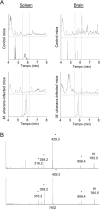Spatiotemporal analysis of mycolactone distribution in vivo reveals partial diffusion in the central nervous system
- PMID: 33264290
- PMCID: PMC7710047
- DOI: 10.1371/journal.pntd.0008878
Spatiotemporal analysis of mycolactone distribution in vivo reveals partial diffusion in the central nervous system
Abstract
Mycobacterium ulcerans, the causative agent of Buruli ulcer (BU) disease, is unique amongst human pathogens in its capacity to produce a lipid toxin called mycolactone. While previous studies have demonstrated that bacterially-released mycolactone diffuses beyond infection foci, the spatiotemporal distribution of mycolactone remained largely unknown. Here, we used the zebrafish model to provide the first global kinetic analysis of mycolactone's diffusion in vivo, and multicellular co-culture systems to address the critical question of the toxin's access to the brain. Zebrafish larvae were injected with a fluorescent-derivative of mycolactone to visualize the in vivo diffusion of the toxin from the peripheral circulation. A rapid, body-wide distribution of mycolactone was observed, with selective accumulation in tissues near the injection site and brain, together with an important excretion through the gastro-intestinal tract. Our conclusion that mycolactone reached the central nervous system was reinforced by an in cellulo model of human blood brain barrier and a mouse model of M. ulcerans-infection. Here we show that mycolactone has a broad but heterogenous profile of distribution in vivo. Our investigations in vitro and in vivo support the view that a fraction of bacterially-produced mycolactone gains access to the central nervous system. The relative persistence of mycolactone in the bloodstream suggests that assays of circulating mycolactone are relevant for BU disease monitoring and treatment optimization.
Conflict of interest statement
The authors have declared that no competing interests exist.
Figures






Similar articles
-
Mycolactone diffuses from Mycobacterium ulcerans-infected tissues and targets mononuclear cells in peripheral blood and lymphoid organs.PLoS Negl Trop Dis. 2008;2(10):e325. doi: 10.1371/journal.pntd.0000325. Epub 2008 Oct 22. PLoS Negl Trop Dis. 2008. PMID: 18941518 Free PMC article.
-
Mycolactone diffuses into the peripheral blood of Buruli ulcer patients--implications for diagnosis and disease monitoring.PLoS Negl Trop Dis. 2011 Jul;5(7):e1237. doi: 10.1371/journal.pntd.0001237. Epub 2011 Jul 19. PLoS Negl Trop Dis. 2011. PMID: 21811642 Free PMC article.
-
Proteomic analysis of the action of the Mycobacterium ulcerans toxin mycolactone: targeting host cells cytoskeleton and collagen.PLoS Negl Trop Dis. 2014 Aug 7;8(8):e3066. doi: 10.1371/journal.pntd.0003066. eCollection 2014 Aug. PLoS Negl Trop Dis. 2014. PMID: 25101965 Free PMC article.
-
Immunity against Mycobacterium ulcerans: The subversive role of mycolactone.Immunol Rev. 2021 May;301(1):209-221. doi: 10.1111/imr.12956. Epub 2021 Feb 19. Immunol Rev. 2021. PMID: 33607704 Review.
-
From Bacterial Toxin to Therapeutic Agent: The Unexpected Fate of Mycolactone.Toxins (Basel). 2023 May 30;15(6):369. doi: 10.3390/toxins15060369. Toxins (Basel). 2023. PMID: 37368670 Free PMC article. Review.
Cited by
-
Molecular Mechanisms Underpinning the Circulation and Cellular Uptake of Mycobacterium ulcerans Toxin Mycolactone.Front Pharmacol. 2021 Sep 16;12:733496. doi: 10.3389/fphar.2021.733496. eCollection 2021. Front Pharmacol. 2021. PMID: 34603049 Free PMC article.
-
Hiding in the yolk: A unique feature of Legionella pneumophila infection of zebrafish.PLoS Pathog. 2023 May 8;19(5):e1011375. doi: 10.1371/journal.ppat.1011375. eCollection 2023 May. PLoS Pathog. 2023. PMID: 37155695 Free PMC article.
-
NAD kinase promotes Staphylococcus aureus pathogenesis by supporting production of virulence factors and protective enzymes.Elife. 2022 Jun 20;11:e79941. doi: 10.7554/eLife.79941. Elife. 2022. PMID: 35723663 Free PMC article.
References
-
- Guenin-Macé L, Ruf M-T, Pluschke G, Demangel C. Mycolactone: More than Just a Cytotoxin In: Pluschke G, Röltgen K, editors. Buruli Ulcer: Mycobacterium Ulcerans Disease, Cham: Springer International Publishing; 2019, p. 117–34. 10.1007/978-3-030-11114-4_7 - DOI
Publication types
MeSH terms
Substances
LinkOut - more resources
Full Text Sources
Molecular Biology Databases

